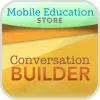Take a look inside 4 images
ConversationBuilder
Pros: Supports learning the pragmatics of conversation: turn-taking, initiation, and staying on topic.
Cons: Images could display more diversity.
Bottom Line: For speech-language pathologists, this is a must-have tool for helping kids learn conversation skills.
Use ConversationBuilder with kids one on one or in small groups to help them build informal conversation skills. It would also be a great way to help kids rehearse before upcoming events or situations that might be awkward for them. Select from the various modules to provide the most timely and relevant topics for kids. Or import a photo of your own in the Group mode to customize the experience further. Replay the conversation and help kids analyze if it was successful and why.
ConversationBuilder helps kids learn to have multiple-exchange conversations with peers in social settings. Designed for kids on the autism spectrum who often have trouble with this skill, ConversationBuilder allows kids to rehearse, learn from mistakes, and ultimately have successful conversations. The app includes seven conversation modules with more than 100 in-app scripts on topics like holidays, animals, and friends. The customization settings include options for varying lengths of conversations as well as who initiates -- the student or peer. The group option allows kids to use the app for guided practice with peers face to face.
Kids see a photo of a social setting and three sentence options; they choose the sentence they think best opens or continues the conversation. If they choose incorrectly, a gentle hint directs them to the better choice. Once they choose the correct response, they can record themselves and playback the recording. Kids get an audio response to their sentence. For example, kids choose "Hi, Becky!" to start a conversation and a little girl's voice responds, "Hi!"
This could be an extremely useful tool for helping kids build social skills and learn how to take part in peer conversations. The independent and group learning options provide valuable customization tools for teachers and great scaffolding for kids; some kids might feel more comfortable interacting with a device on their own before they practice the same skills with peers. The topics and images are relevant, and the recording feature engages kids in a more personalized experience. Kids who are blind or who have motor impairments can still access the app with help. Kids who are nonverbal can select the correct choice, and someone can voice for them, or they can record themselves if they use AAC with voice output.
Kids get guiding feedback when they select incorrectly, but not all of the feedback is specific. For example, kids sometimes get specific advice like "It's not quite time to change the subject." But other times responses are less specific, such as "That's an unusual response." A more direct approach for all feedback might help kids understand why one choice is better than another. In addition, more racial and ethnic diversity in the images might help more kids identify with the conversations and topics.











